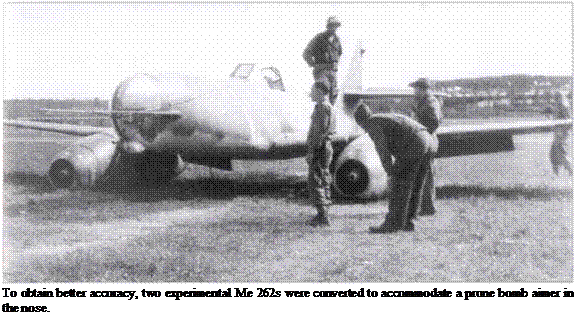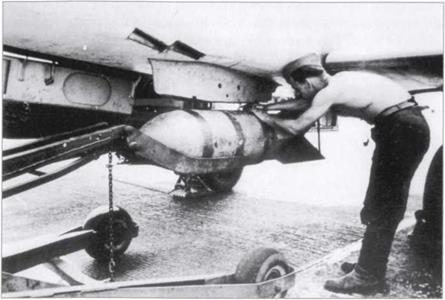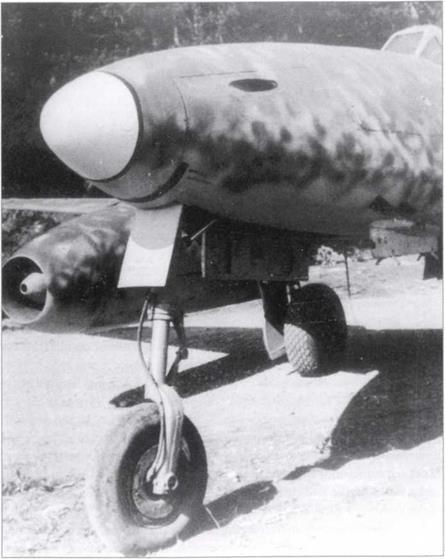Prague – The Last Station
Meanwhile it was not only the situation on the ground that was becoming more confused. On 27 April, Luftflotte 6 surprised JV 44 by ordering it to return all its Me 262s to KG 51 Edelweiss, after which KG 51 was to proceed forthwith to Prague-Rusin to strengthen IX Fliegerkorps. During the flight as many enemy positions as possible along the River Regen were to be attacked. After bad
|
Bombing-up an Me 262 A-l/bo. with two SC 250s. |
weather held up the transfer, on 28 April Luftflotte 6 ordered JV 44 to fly escort for I./KG 51. Because a direct flight was ruled out, and a reserve supply of J-2 fuel existed at Horsching/Linz, a detour was arranged to Lower Austria to refuel. Once they reached Prague units of KG 51 under Hauptmann Abrahamczik were to assist in the defence of Berlin, and in particular carry out low-level attacks on the supply lines to the rear of the Soviet 3rd and 4th Guards Tank Armies.
On 30 April, seven Me 262s of I./KG 51 arrived at Horsching. Most of II./KG 51 had been overrun by US XX Corps near Straubing on 29 April and captured. On 1 May I./KG 51 headed for Prague where it was redesignated KG 51 Prague. Next morning Me 262 Blitzbomber units attacked Russian troops in the Berlin area for the first time. Targets at Bautzen, Hoyerswerda and Kamenz were also bombed. Several Me 262s were damaged by barrages of antiaircraft fire. On 2 May, Luftflotte 6 ordered IX Fliegerkorps (J), to which KG 51 Prague was attached, to operate exclusively to the east, all attacks on the Western Allies requiring prior approval from above. However, on 5 April an uprising broke out in Prague leading to heavy fighting between the insurgents and units of the Wehrmacht and Waffen-SS.
After the uprising began, KG 51 pilots attached to the newly formed Jabo unit Hogeback flew dangerous low-level missions, while some II./KG 51 pilots even joined in the house-to-house street fighting in Prague’s Jenco district. On the orders of the German city commandant, the jets were to drop containers of incendiaries. Amongst the most important targets was the area near Prague-
Stred central railway station. During a lull in the fighting on the night of 6 May, the insurgents erected more than 1,500 barricades in the streets. That same afternoon a Jabo unit destroyed Prague radio station, which had fallen into insurgent hands, with SD 250 and SD 500 bombs. Some of these fell in Wenceslaus Square.
Ground staff attempted to fight through to Pilsen with part of General Vlasov’s anti-communist Russian force. While General Vlasov was negotiating
|
The series-produced Me 262 A-2a Blitzbomber had a reduced armament of two MK 108s and was operated mainly by KG 51. |
 |
to change sides, his troops surrounded Prague-Rusin airfield. On 7 May, Me 262 pilots then bombed the Vlasov units around their own airfield while German troops in Prague launched a massive counter-attack against the insurgents. II./KG 51 had arrived meanwhile at Eger (Saaz) and was serviced by JG 7 ground crews. Six Me 262s were bombed-up and flew to Prague where two were lost. The machine of Unteroffizier Pohling was shot down by insurgents over Prague old city, Leutnant Heinz Strothmann also lost his life when his badly damaged machine crashed during the return flight.
On 7 May, after Germany’s overall capitulation had been announced, the last four pilots taxied their machines to the runway at Saaz having been informed by Hauptmann Abrahamczik that on the orders of Luftflotte 6 all aircraft were to be delivered to the Western Allies to prevent the modern Me 262 jet bombers falling into Red Army hands. At 1430, Leutnant Wilhelm Batel flew his Me 262 A-2a from Saaz to Liineburg and landed in a field two miles from his family estate at Pomeissel. It was a wheels-up landing but he emerged unharmed. 2./KG 51 Staffelkapitan Hauptmann Abrahamczik and Oberleutnant Haeffner landed at Munich-Riem and surrendered their aircraft to US forces. The fourth pilot, Oberfahnrich Frohlich, touched down at Fassberg where RAF fliers invited him to join their victory celebrations. Two days later they captured him ‘officially’ and he went into a PoW camp.
From the summer of 1944 Edelweiss squadron received a total of 342 Me 262 A-l fighters, Me 262 A-la Jabos and Me 262 A-2a. This represented a third of
all delivered Me 262 production. Of these aircraft at least 88 were lost in action and another 146 to technical defects. The remainder were given to JG 7, KG(J) 54 and JV 44. Kommando Stamp at Oranienburg received five, three went to the air reconnaissance wing and one machine to KdE. Thus only four remained on 8 May.
In the estimation of OKL, the Me 262 A-l and A-2 Blitzbombers were litde suited to low-level attack against small ground targets because they had no proper bombsight. It was also very difficult at such high speeds to hit battlefield targets like lone tanks, locomotives and bridges, although it was rare for AA fire to hit a jet for the same reason.












